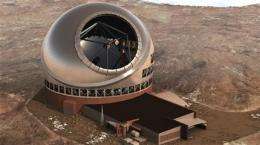China, India to jump forward with Hawaii telescope

China and India are catapulting to the forefront of astronomy research with their decision to join as partners in a Hawaii telescope that will be the world's largest when it's built later this decade.
China and India will pay a share of the construction cost - expected to top $1 billion - for the Thirty Meter Telescope at the summit of Mauna Kea volcano. They will also have a share of the observation time.
It's the first advanced telescope in which either nation has been a partner.
"This will represent a quantum leap for the Chinese community," Shude Mao, professor of astrophysics at National Astronomical Observatories of China, said in a telephone interview Wednesday from Waikoloa on the Big Island, where he was attending a meeting of the telescope's scientific advisory committee.
The Thirty Meter Telescope's segmented primary mirror, which will be nearly 100 feet - or 30 meters - long, will give it nine times the light-collecting area of the largest optical telescopes in use today. Its images will also be three times sharper.
G.C. Anupama, professor at the Indian Institute of Astrophysics, said the largest telescope in India has a 2-meter mirror, though the nation is currently building one that will be 4 meters long.
"So it's a huge jump for us from the 4-meter to the 30-meter," Anupama said in a telephone interview from the sidelines of the advisory committee's meeting. "It definitely will take Indian astronomy to greater heights."
The telescope, known as TMT, will be able to observe planets that orbit stars other than the sun and enable astronomers to watch new planets and stars being formed. It should also help scientists see some 13 billion light years away for a glimpse into the early years of the universe.
The University of California system, the California Institute of Technology and the Association of Canadian Universities for Research in Astronomy founded the telescope, which is expected to be finished in 2018.
China joined as an observer in 2009, followed by India the next year. Both are now partners, with representatives on the TMT board. Japan, which has its own large telescope at Mauna Kea, the 8.3-meter Subaru, is also a partner.
TMT may not hold the title of world's largest for long, however, as a partnership of European countries plans to build the European Extremely Large Telescope, which would have a 42-meter, or 138-foot, mirror.
Anupama said India hopes being a partner will allow the country to acquire critical technology that would help it build a 10-meter telescope at home.
Indian scientists would be interested in using the TMT to study the Milky Way galaxy and some of the oldest stars in the universe, she said.
India expects to contribute 10 percent of the telescope's construction cost. Seventy percent of this will be in kind, in the form of equipment and parts.
Mao said Chinese astronomers would likely want to use TMT to study the origin of planets outside our solar system, black holes, dark matter and dark energy.
China has leading theoretical astrophysicists, but it lags in the field of observational astronomy, Mao said. The telescope will help China overcome that.
"China is ambitious in terms of its science goals. Really it wants to catch up as fast as we can," he said.
He said China would contribute at least 10 percent of the construction cost, and more if its budget allows. Like India, 70 percent of its contribution will be in-kind.
Mao said the project will also be valuable for the image China broadcasts to the world.
"There are many things that are manufactured in China, but we want to move up in terms of technology," he said. "We also want to make contributions to world peace. TMT offers a great opportunity to do this."
All astronomers, wherever they are from, look at the same sky, he said.
©2012 The Associated Press. All rights reserved. This material may not be published, broadcast, rewritten or redistributed.


















